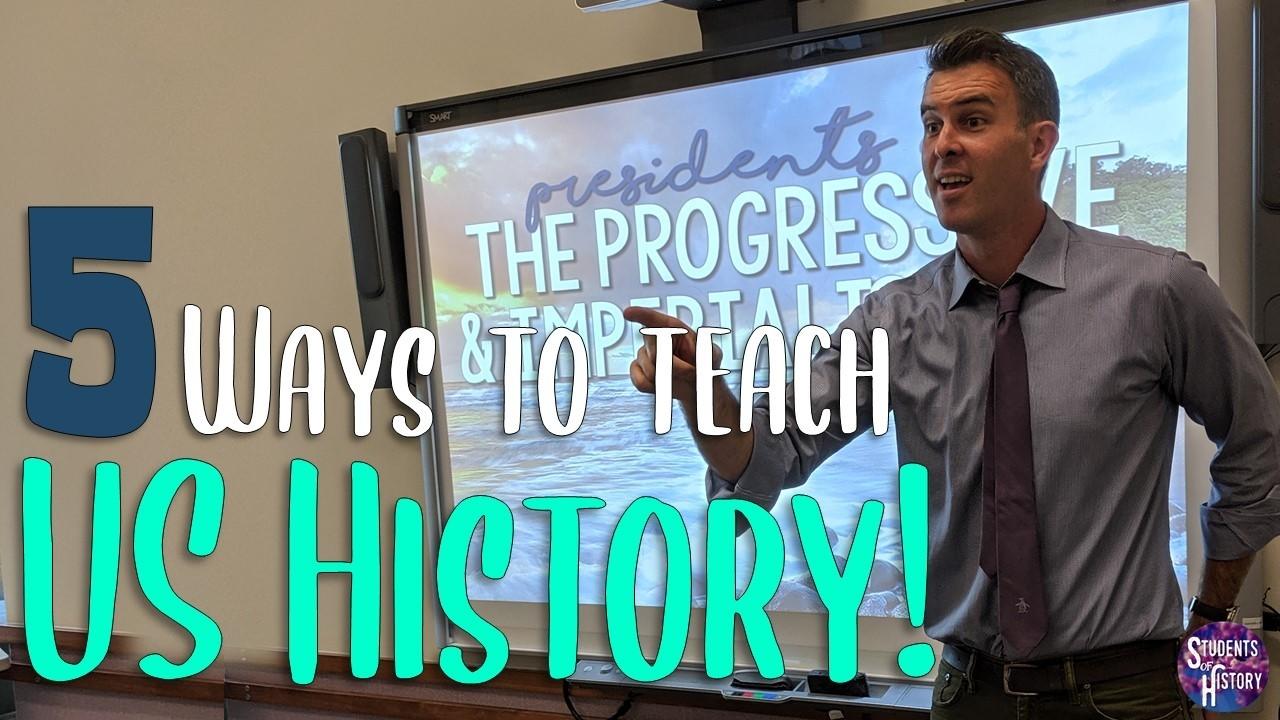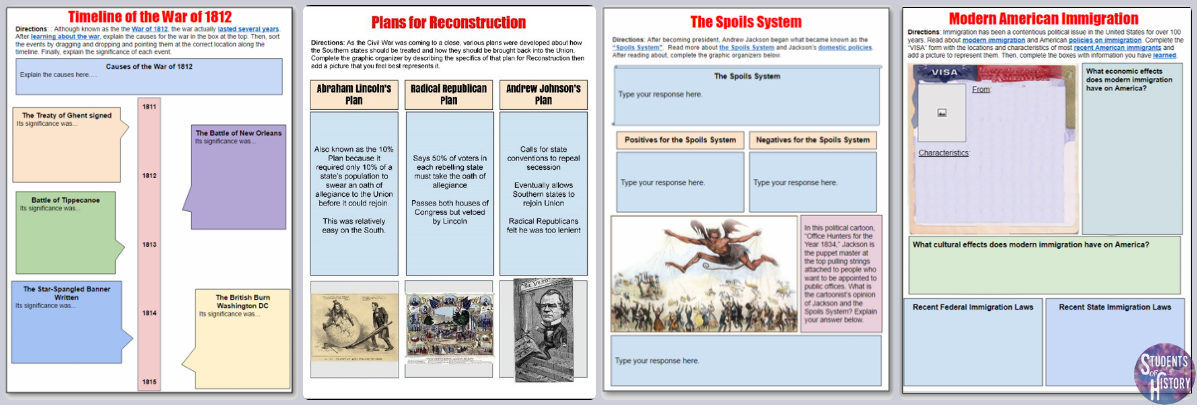5 Ways to Teach ALL of US History

There is no one way you need to be teaching US History. Every teacher has their own preferred way to run their classes. How you teach your classes is really up to you and what’s best for you and your students.
You might prefer a very structured classroom with routines that students stick to the whole year. Or, you may prefer to mix things up and keep students on their toes with different activities for each unit. Either way can work very effectively!
Over my years teaching US History, I developed a host of resources and teaching strategies that I found to be effective for different groups of kids. Here, I want to share 5 teaching strategies/resources you can use either as the backbone of your curriculum or to mix things up so that each unit has a new feel.
Each method can be combined with inquiry lessons, primary resources, station activities, and Project Based Learning to ensure you’re preparing your students and providing critical thinking opportunities. However, these 5 strategies can provide you resources to guide student learning and ensure that you’re covering everything students need to learn about US History.
ALL of these are included in my US History curriculum. However, I’ve also included links to each individual resource for US History if you know you just want to use that strategy!
1) Unit Guide Packets
Packets are a tried-and-true method that history teachers have been using for decades. They help keep students organized so that everything they need is in one place. They don’t need to keep track of a bunch of different papers. Everything they need for the whole unit is in one handy packet.
My packets are designed to help students understand exactly what they need to know. Each packet is 9 pages and begins with a short reading on that era/unit of US History. Then, there are pages on vocabulary important people, geography, a timeline, key concepts, and image analysis.
Students receive the packet one the first day of each unit and are responsible for completing it by test day. This way, they always have something to work on and know exactly what they should study for the test.
There’s also editable Google Docs versions of the packets. These feature links to great online sources and is perfect for those of you who have gone paperless or use Google Classroom.
You can check out the bundle of all 18 unit packets here to learn more!
Recommended For:
Teachers looking to help students with organization and ensure they cover everything in the curriculum.

2) Digital Notebooks
Digital notebooks are similar to packets in that they include everything for a unit in one place. However, they also provide some more engaging and interactive activities for students to complete.
Each set includes about 8-12 pages on key aspects of that unit in American History. Students type directly on the pages, insert images, and drag and drop information for a variety of engaging, interactive activities.
They are a fantastic way to integrate technology into your classroom and can be completed without printing any paper! They can be completed all online on laptops, tablets, or any other device that supports Google Drive! Awesome for a 1:1 school or just a trip to the computer lab.
Since they are entirely digital, they’re not best for students who learn better from printed materials and prefer to read/study from notebooks or paper. However, they are great in that students can access them anywhere and study from their phones and don’t have to worry about losing any important papers.
There are 150+ digital notebook activity pages in my US History curriculum! Each set is broken out by unit and includes links to great online sources, an answer key, and pages on each aspect of the unit.
Recommended For:
Teachers in a 1:1 school, those using blended learning, or with a mandate to integrate more technology in their classroom.

3) Interactive Notebooks
Interactive notebooks have been around for awhile now and are still a great tool to use in the classroom. The graphic organizers help kids categorize and better understand content. Plus, students also almost always enjoy making them.
These are graphic organizers that students cut out and glue into their notebooks to use for studying any content you need to cover. You can use them every day as a portion of your lesson or mix them in occasionally.
The hands-on and creative aspect of interactive notebook activities lend themselves to fostering student creativity and allowing your kids to demonstrate an understanding of key concepts in your curriculum.
I have over 100 interactive notebook pages in my US History curriculum that cover every major concept from the 13 Colonies through the end of the Cold War. Each set includes pictures of completed pages, full answer keys, and cut-and-fold graphic organizers for every major topic.
If you’re not sure about how to best use interactive notebooks, I also have this blog post on a few strategies!
Recommended For:
Students who benefit from hands-on learning and help with organizing key content.

4) Flipped Classroom Videos
A “flipped classroom” is where students watch an instructional video at home and do the typical "homework" in class, where the teacher can provide more guidance. It's a great strategy to take lectures out of the classroom and save more time for projects, primary source analysis, and other engaging in-class activities.
My US History curriculum includes 37+ videos that cover every major concept. Each is a fully-narrated overview of a topic that explains key concepts, people, terms, and events in ways that students can understand. You can preview one of them on the Watergate Scandal here.
You can learn more about flipped classroom videos here and download all the guided notes and get access to all the videos here.
Recommended For:
Homeschoolers, teachers who aren’t 100% confident in their content knowledge or who want to try flipping their class.
5) PowerPoints with Guided Notes
Of course, one of the traditional mainstays of teaching is lecturing or presenting content through PowerPoints. While some may stigmatize it, most of us still likely need to go through a PPT with kids every now and then to cover a major concept.
Also, our PowerPoints aren’t your traditional ones you might remember from school. Each one is visually-engaging and stimulating for students. There’s also ones filled with mind-blowing 3-D images and some with cool moving portraits that bring historical figures to life. If you want to check out more on these, I have this blog post about creating “insta-worthy” classroom experiences.
If you are concerned about the dreaded “L-word” I have this blog post on 6 ways to avoid lecturing in social studies!
Recommended For:
Any teacher, really! However, more traditional-minded teachers in classrooms would certainly benefit from everything created and organized for you.
That’s All Folks!
Hope you enjoyed this overview of 5 great methods you can use to teach your full year of US History. Remember, you get ALL of them when you sign up for our US History curriculum. You can also snag each one individually through the links above.
If you have any questions about a resource please don’t hesitate to reach out!
Happy teaching!

Want to try some lessons for free?
Enter your email to download over 30 pages of free, engaging social studies resources!
Don't worry, your information is never shared.